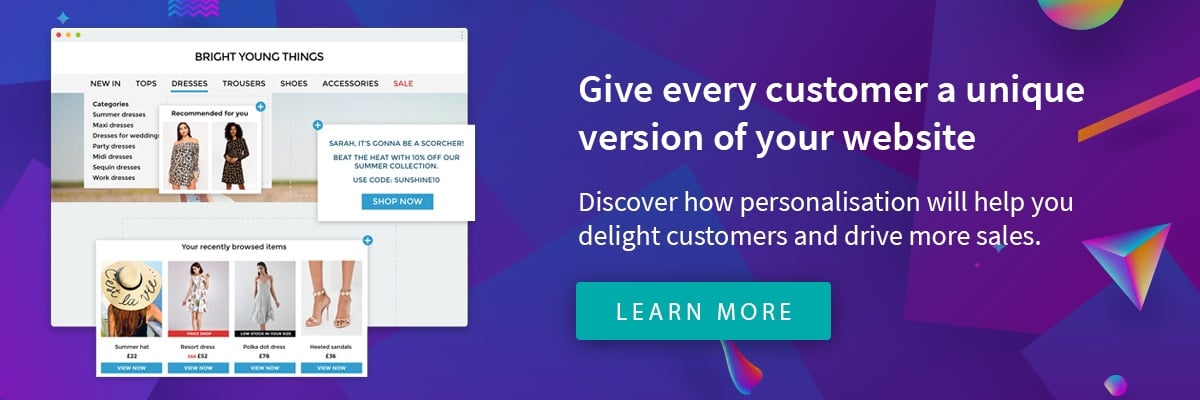As we’ve explored on the Pure360 blog before, browser and basket abandonment is a common problem in the world of eCommerce. But what makes consumers leave without completing their purchase and how can eCommerce sites encourage them to stay?
In this blog post, we take a look at eight reasons why people leave your site without purchasing and what you can do to combat them. Read on to understand how you can avoid spending your time and money generating traffic that doesn’t convert into sales.
1) Not ready to buy
In some cases, the browser might not be ready to buy. They might be simply researching a potential purchase and comparing prices or they may have decided to complete their purchase offline. This can be especially true in the electronics, appliances, and travel markets where consumers spend hours on research.
Prompt them to purchase today with an email which reinforces why they need to buy now. For example, you could send an alert about an expiring offer or low stock. Using a countdown timer can help bring your message to life, and create a sense of urgency.
If urgency doesn’t work, reassurance might. Social proof and reviews rating are both useful tools to offer reassurance and encouragement. Social proof such as how many people are viewing a product can be displayed while people browse, as can star ratings or reviews.
To stay top of mind when a browsing session finishes, try following up with an automated email featuring the ratings and reviews of the specific products they were looking at. This can help to convince them they’re making the right choice.
2) Put off by cost
Realising your order is actually adding up to far more than you thought can be off-putting. The fear or guilt caused by ‘basket shock’ as it’s sometimes known, when you suddenly panic about how much you’re spending, can be one of the major reasons for abandoning baskets.
Make sure your checkout is easily editable so shoppers can adjust their orders to reduce the total cost. You can even consider offering free shipping or a discount on certain spend thresholds to make them feel like it’s an offer which is too good to miss.
3) It just took too long
Shoppers are impatient creatures. They don’t want to be kept waiting, and if they are, they’re likely to abandon their baskets.
Present them with relevant and personalised website content so they don’t have to search around to find what they’re looking for. And make sure the content loads quickly so that it’s easy to browse and buy on mobile.
Remember to avoid putting people off by asking them to complete too much information. To really speed things up, consider offering a quick one-click payment option like Paypal to make the process even more streamlined.
4) Hidden or high delivery costs
People still balk at how much retailers charge for delivery, sometimes preferring to log-off and head into town to save the extra cost.
Offer free delivery on purchases over a certain amount or click-and-collect so they can get their goods without expensive delivery charges. And be clear about what you charge at the very start of the customer journey so they don’t get a nasty last minute surprise.
5) Need it the next day
It’s annoying having to wait for something you want now. Clearly show how long consumers have to wait for delivery throughout your site and offer the option of next day delivery.
After they order make sure shoppers are kept up-to-date with the progress of their delivery with personalised email or text alerts so they know when to expect their parcel.
6) Frustrated by needing to sign-up
Sometimes just setting up an account, registering your details and logging-in can just be too much hassle.
Don’t make your customers jump through hoops to buy from you—let them shop on their own terms and check out as a guest. So long as you have their email address you can always contact them later to ask them to set up an account and provide more information.
7) Technical difficulties
There’s nothing more frustrating than being caught in a check-out that you can’t seem to check out from. People lose cards, passwords and sometimes just can’t figure out which fields they need to fill-in to progress.
Always provide a way to reset passwords using reminders and clearly display your customer service number in case people just want to speak to another human to complete their transaction.
8) Afraid online shopping is less secure
Some people just don’t want to transact online. Reassure every customer by always promoting your secure payment procedure, easy returns, and refund policy and tell them that you won’t sell or share their data.
Providing useful product information, ratings and reviews, or video content can help to reassure them that what they’re buying online is a safe purchase.
Takeaway
Putting the tactics we’ve explored in this post into practice can help you to tempt more people to complete their purchase and increase your online revenue.
Try as we might to pre-empt and combat basket and browser abandonment, sometimes there isn’t a specific reason someone fails to complete a purchase—they may have simply been distracted. A timely basket abandonment email sent after customers leave can recapture lost attention and encourage browsers to return and buy.
Central to all of the ideas we’ve covered is the need for clear, timely, and relevant communication that keeps customers engaged. Behavioural targeting and personalisation technology allows you to re-target and re-engage customers, encouraging them to find, return to and buy exactly what they were looking for.

